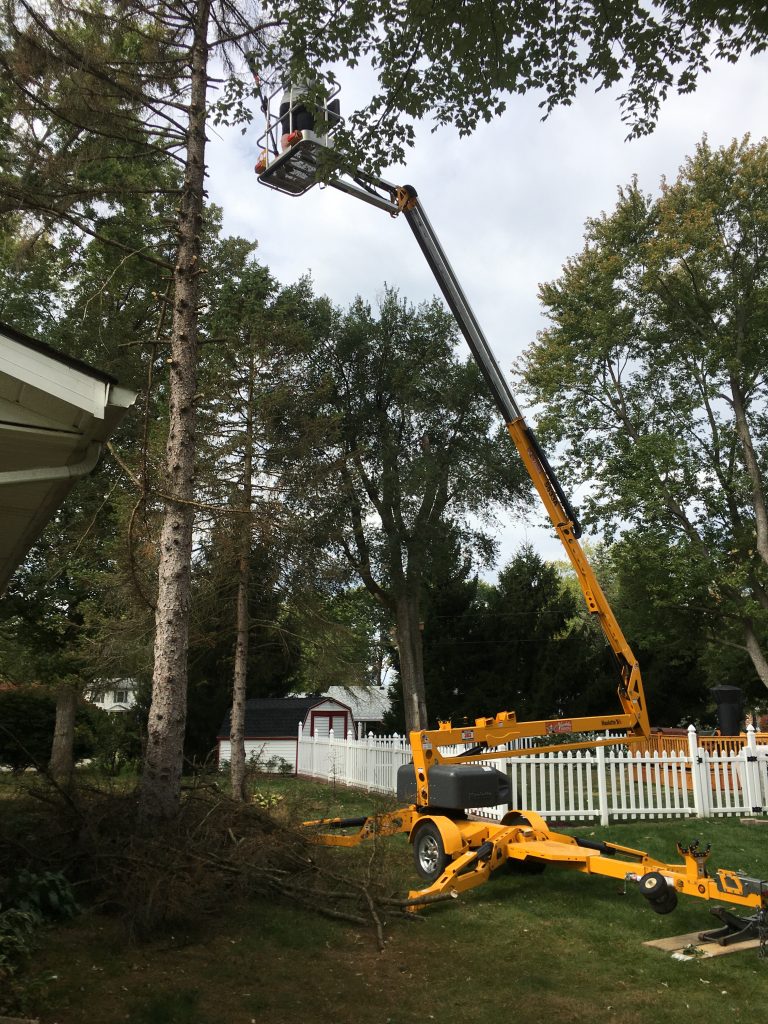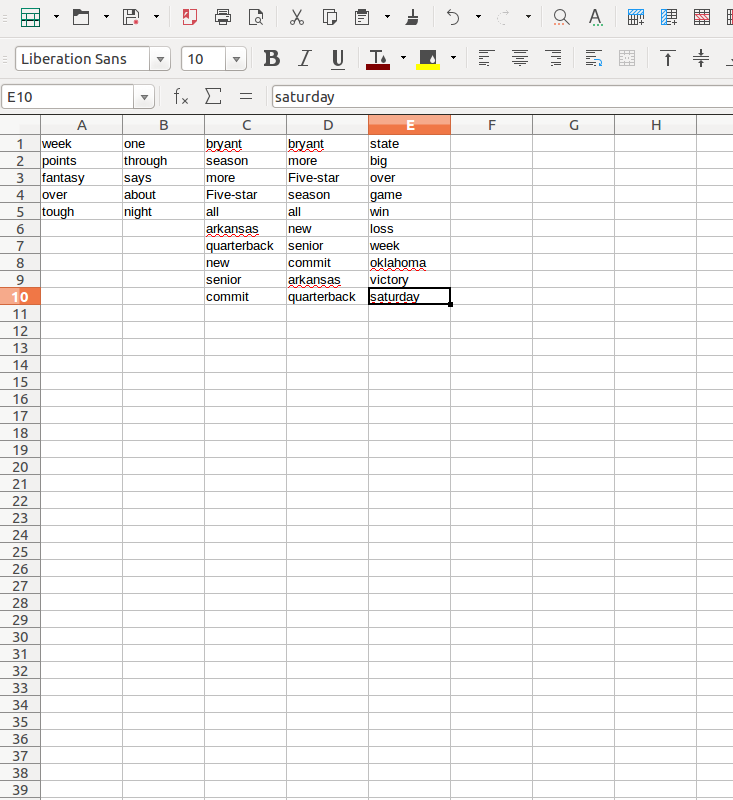The fear of cutting wood at heights
Also: Phobia Quotient!

The neighbors rented a boom.
(A tangent here–I don’t think I’ve ever created a name for these neighbors, probably because they’re nice and reasonably normal. I’ve just called them by their first names: Brian and Kelly. Let’s change that now. I shall call them the Busybees. Because they’re always rather busy.)
Anyway, they hate trees. Well, to be fair, all Ohioans hate trees. Almost as much as they hate dressing appropriately for the weather. Liz is a prime example. She also hates trees. Here’s a typical conversation:
Statement: “This tree looks a little brown.”
Response: “Cut it down!”
Statement: “This branch looks dead.”
Response: “Cut it down!”
Statement: “This tree isn’t perfectly erect.”
Response: “‘Erect’…*teehee….Cut it down!”
But this year the trees in question really did look dead, and so I agreed after much insistence to cut them down. Liz, the Ohioan, had already been convinced.
Cut it down!
So after this roundabout lengthy preamble, I arrive at the point of my post: I don’t like heights. Never did. Figured those who do are idiots or showoffs. Of course, in my youthful egocentric stubbornness, I forced myself to endure them. Indoor rock climbing, rappelling, mountain hiking, amusement parks–been there; done that. And while being young grants a greater allowance for risk in the face of death, probably due to the amount of testosterone that was oozing out of my every orifice, approaching middle age has forced a more practical approach to death–like fearing things that cause it.
Consequently, my parasympathetic nervous system now strongly advises me that death should be avoided and doing certain things increases its risk potential.
But damned if I didn’t try. I went up there twice and cut branches, though in the end, Liz did the bulk of the work.
So this got me thinking. Is my phobia truly debilitating, or just a common healthy fear of death, albeit somewhat too strong? Internet time!

I didn’t vet this information at all, but it seems sound. Let’s see how I stack up:
- Snakes? Some Indiana Jones shit right there. But they do have a creepy shape and are among the few large terrestrial animals that are venomous, so I get it. I do not have this fear. Pass.
- Heights. Already discussed. Good to know this is #2. Fail.
- Public Speaking. I don’t really think this is a phobia. It’s anxiety over social acceptance, not a life or death scenario, unless you consider the tribal fear of being banished which might lead to death. Exempted.
- Spiders. See #2, though they’re smaller. I like spiders. Pass.
- Claustrophobia. I don’t like being restrained, probably from childhood memories. My parents thought it was funny to sit on me for extended lengths of time. Sick Boomer humor. But small places don’t bother me. Pass.
- Airplanes. Nah. I hate them more than fear them. Smell farts for hours, get felt up by security, then packed in like an Amazon warehouse. But not fear. Pass.
- Mice? No. Pass.
- Needles. I hate getting poked. Triggers a primal fear, though I don’t have a panic attack from it. Pass.
- Crowds. Nah. Just an inconvenience. Pass.
- Darkness? Only after watching Alien or Jurassic Park. Pass.
- Blood? Only my own. Pass.
- Dogs. I love dogs. Pass.
- Clowns? I hate them, but it’s not fear. Sort of like cats. Shoot them for entertainment, but that’s it. Pass.
My total score: 1/12. But, these are weighted based on commonality, so I will use sketchy math to quantify this.
I’ll take the inverse of each item (only counting the “very afraid” numbers, because really, most of us are probably “a little afraid” of many of these, which does not a phobia make), multiplying by 100, and excluding #3, the total equals 169.9. This is the total max sissy quotient, which I’ll set as the baseline of 100% total sissy.
I posses #2, inverse of which is 4.2. Then to scale it with the baseline, that’ll be 4.2*100/169.9, which equals 2.5%. I am a 2.5% sissy.
But where is the median sissy? I really don’t know, because I don’t see these as cumulative probability, so let’s take a nice midpoint in the range: 5+((32-5)/2)=18.5. 1/18.5*100=5.4. 5.4*100/169.9=3.2% sissy. So I’m lower than baseline, according to my questionable math from unvetted sources.
I guess I’m pretty normal after all.
But you’re a total sissy if you fear blood.
–Simon



 Of course, that nightmarish formula is more readily understood in its natural format: a spreadsheet, so naturally I’ve provided it along with instructions:
Of course, that nightmarish formula is more readily understood in its natural format: a spreadsheet, so naturally I’ve provided it along with instructions:
 Sadly, I could not find an online calculator that provides coffee products by cost per ounce. Searching for one only yielded a number of self-righteous articles criticizing how much coffee costs and how stupid people are for buying Keurigs or going to coffee shops. But I did plug some numbers into the calculator, and my own coffee preference: Peet’s, ranks approximately by cost the type of coffee I should be buying. So once again, the math doesn’t lie:
Sadly, I could not find an online calculator that provides coffee products by cost per ounce. Searching for one only yielded a number of self-righteous articles criticizing how much coffee costs and how stupid people are for buying Keurigs or going to coffee shops. But I did plug some numbers into the calculator, and my own coffee preference: Peet’s, ranks approximately by cost the type of coffee I should be buying. So once again, the math doesn’t lie: